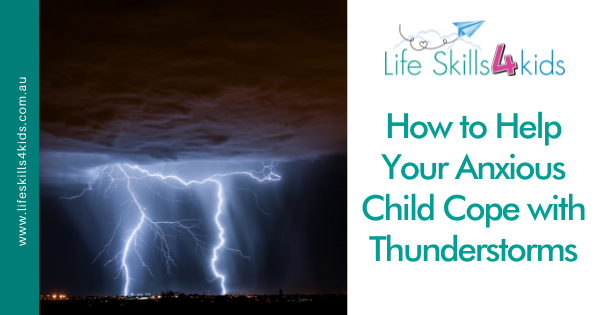The warmer months of the year bring all kinds of fun such as swimming, picnics, and fun outdoors. Kids love to play outside and kick off their shoes. Unfortunately for some, the warmer months also bring thunderstorms. And while some of us love a good thunderstorm, if you have an anxious child, you will know that thunderstorms are not fun. For some kids they are a source of sheer terror and as a parent, you have to try to calm them down, keep them safe, and help them cope.
Thunderstorms Cause Sensory Overload for an Anxious Child
For some kids on the autism spectrum and others with Sensory Processing Disorder or sensory sensitivity, thunderstorms cause sensory overload and they can’t cope. It’s a common fear among all children but for kids with anxiety or sensory issues, their fear goes to a whole new level. So what can you do as a parent to reassure your child and restore calm to the situation?
1. Ask Open-Ended Questions
With some kids, talking them through their fears is a strategy that works well. Ask open-ended questions about why they are afraid of storms – is it because of the noise or the flashing of the lightning? Is it because they are worried there will be a blackout and it will be dark? Do they fear something bad happening as a result of the storm? Does it bring back memories of a time that something bad did happen to themselves or someone else because there was a storm?
Once you find out what the specific fear is, be as reassuring as you can. Try to help them to reframe the fear into something less scary – such as the thunder being just sky giants playing with their bowling balls. Try to find something about the situation that makes your anxious child laugh. Funny fears are not as big and scary when they are reframed that way.
2. Use Distraction Techniques
Some children respond well to being given something to do. You can use this time to suggest that you snuggle up for a story or some special family time. Try to keep everyone in the family together so that they feel reassured that everyone is safe.
3. Play Thinking Games
You can suggest that you play a game using your minds; some kids find this technique engaging and will readily take up the challenge. You could think of all the animals or foods that start with a particular letter of the alphabet, or you can play a guessing game where one person thinks of a word and gives everyone else clues until they guess it. There are many ways that you can be creative with thinking games.
4. Use Headphones
For kids that struggle with the noise of a thunderstorm, noise-cancelling headphones work well. Try to find a comfortable spot in the middle of the house away from the windows where your child can put on the headphones and read a book, watch their favourite cartoon on an iPad, or snuggle up with you or a pet.
5. Give Your Anxious Child Something to Hold
Sometimes an anxious child will find it reassuring to have something to hold, especially if it is a favourite comfort item. Try giving your child a favourite stuffed animal or blanket or a fidget toy. Your child may find it calming to hold something that is special as a way of distracting them from their fears.
6. Prepare Ahead of Time
For some kids, it’s important to know ahead of time that you are prepared if storms come. This is especially applicable to autistic kids. You can involve them in the preparations and reassure them before a storm strikes that your emergency plans are alive and well. You can prepare a visual reminder of what your family plan is if you lose the power, where the emergency supplies are, and what you will do if someone is injured. Then when your anxious child needs reassurance, you can go over the visual with them and take them to see for themselves that all the preparations are in place if you need them.
7. Make it an Adventure
While an anxious child might fear storms because they are unpredictable, you can turn the unexpected into an adventure. If you lose the power, for example, you can tell your child that you’ll have to eat all the ice cream before it melts and so you’re going to have an ice cream party. Or you can build a “cave” out of a table or chairs and blankets and all get in it for a special story by torch light. Kids love the imagination and adventure that goes with this approach and it might be an effective distraction from the storm. It’s also likely to be a fond childhood memory in later life of the time that you all got under the table in a special cave because there was a storm.
Storms can be scary, but you can help your child cope with a little thought and planning. If you would like to know more, feel free to contact us. We would love to hear from you!

